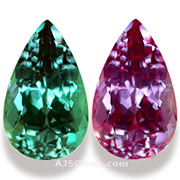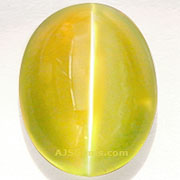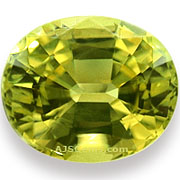Chrysoberyl is one of the most distinguished gemstone families, featuring two of the most important varieties in the gems world -- alexandrite and chrysoberyl cat's eye. But even the ordinary yellow-green chrysoberyl is a fine gemstone, with excellent hardness and brilliance.
 |
 |
 |
| Color-Change Alexandrite |
Cat's Eye Chrysoberyl |
Chrysoberyl |
Chrysoberyl is an aluminum beryllium oxide by chemical composition and belongs to the orthorhombic crystal system. Despite the name, chrysoberyl is not related to the beryl family, which includes emerald, aquamarine and morganite. The beryls have a different chemical composition (beryllium aluminum silicate) and different (hexagonal) crystal structure.
One of chrysoberyl's great attractions is its excellent hardness -- it is rated 8.5 on the Mohs scale, just below ruby and sapphire. So chrysoberyl is suitable for any type of jewelry. Chrysoberyl also has a high refractive index, in a similar range as brilliant gems like tsavorite garnet.
The most famous chrysoberyls are the color-change alexandrite and the chrysoberyl cat's eye. Rare alexandrite, colored by traces of chromium, shows a strong color change under varying light conditions. The best examples display an emerald green under daylight and a raspberry red under incandescent light.
Chrysoberyl cat's eye is valued for its very distinct cat's eye that shows under every kind of light. They are found in a variety of colors, including green, yellow, golden and brown. The yellow or golden is the most valued, since it shows a distinctive milk and honey effect on opposing sides as it is turned in the light. Rare specimens of alexandrite may also display the cat's eye effect.
 |
| Vanadium Chrysoberyl |
There is also a rare chrysoberyl containing vanadium that displays a mint green or bluish green color. These unusual vandadium chrysoberyls have thus far been found only in Tanzania.
The chrysoberyls that don't display a color-change or a cat's eye are known simply as chrysoberyl. They are found in yellow, golden, green and brown. These are fine gems in their own right, with a vitreous luster and excellent brilliance. Well cut specimens display impressive fire and compare favorably with yellow or green sapphires. But even though chrysoberyl is completely untreated, it sells at a fraction of the price of heated sapphire. That makes chrysoberyl a great value in today's gem market.
Chrysoberyls are found in Brazil, India, Burma, China, Tanzania, Madagascar, Zimbabwe and Sri Lanka. Alexandrite and chrysoberyl cat's eye tend to be quite expensive due to their rarity, but ordinary chrysoberyl continues to be very affordable.
See our collection of Fine Color-Change Alexandrite
See our collection of Chrysoberyl Cat's Eye
See our collection of Yellow and Green Chrysoberyl